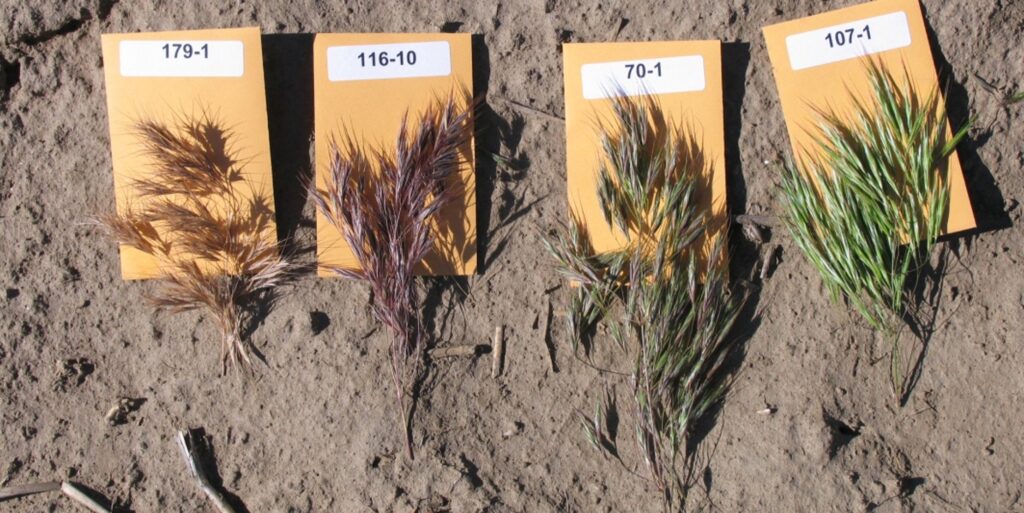By Samuel Robert Revolinski
My name is Samuel Robert Revolinski. I am a postdoctoral research associate at Washington State University (WSU) working with the applied research weed scientist Ian Burke on understanding genetic variation in weeds that drive adaptive traits. With my entire Ph.D. dissertation written on cheatgrass (Bromus tectorum L.), a nearly obligate self-fertilizing weed, I am an expert in under standing the genetic variation underlying adaptive traits in self-fertilizing weeds.
Implicitly, many of the best management practices (BMPs) for reducing herbicide resistance in weed populations are focused on reducing genetic variation in weed populations that drive the occurrence of herbicide resistance. However, herbicide resistance is not the only adaptive trait in weeds that is controlled genetically. Cheatgrass populations have massive amounts of genetic variability within and between farm fields, and thus, adaptive ability between and within farm fields. For example, in Moscow, Idaho, two cheatgrass genotypes collected from the same farmer’s field began flowering 26 days apart in controlled, replicated, greenhouse trials. Thus, genetic variation in weed populations can be detrimental to farmers in other ways.
Herbicide applications in wheat are often timed for specific maturities of the crops and weeds to be effective, so when weeds like cheatgrass vary up to a month in flowering time within a single farmer’s field, postemergence herbicide applications become less effective. In fact, four out of five cheatgrass samples that are suspected of glyphosate resistance sent by farmers into the herbicide resistance screening program at WSU are not actually glyphosate resistant. Likely, the perceived resistance is due to variation in emergence or flowering time of the cheatgrass present within the farmer’s field that allowed those genotypes to escape the herbicide application.

The mechanisms that maintain adaptive genetic variation in self-fertilizing species were unknown until recently. In outcrossing species such as humans, the mechanism thought to maintain genetic variation in adaptive traits is called “the heterozygote advantage” or “over dominance.” In plain English, this means that having a single copy of a mutation rather than two or zero copies of the mutation lead to the most adapted genotype. For example, in humans, having a single copy of a mutant hemoglobin gene can lead to 89% increase in resistance to malaria, but two copies of the mutation lead to sickle cell anemia. Thus, in areas with high incidence of malaria, individuals with a single copy of the hemoglobin gene are the most likely to survive, which in turn, always makes sure that the sickle cell trait mutations and the normal gene are always present in the population. However, in self-fertilizing species, there are no heterozygotes (single copies of mutations in individual plants), thus the heterozygote advantage cannot explain the genetic variation present in populations of self-fertilizing weeds such as cheatgrass.
Recently, with the help of Dr. Richard Gomulkiewicz, a highly influential evolutionary biologist/mathematician at WSU who unfortunately recently passed away, we were able to use stochastic simulations to explain the variation present within farm fields for self-fertilizing weeds. What we found is that specific farms act as a refuge for cheatgrass genotypes that are adapted to the farm, then migration between farms maintains the variation present within farms. Without farm-scale selection of the weeds and migration of seeds between farm fields,
there could not be variation present for self-fertilizing weeds. This means that the adaptive ability of cheatgrass relies on migration of seeds between sites. If there was no migration of seeds between farms, cheatgrass genotypes would have little genetic variation to adapt to management strategies. Thus, managing cheatgrass in the long term requires that migration between farm fields is considered.
The migration of cheatgrass seeds between farm fields can occur through a few different mechanisms but is primarily driven by agricultural activity. Although migration of cheatgrass seeds between fields can occur through migration on wildlife, such as birds or deer,
human activities associated with farming transports large numbers of seeds directly between fields. Birds can transport plant seeds for thousands of miles, but the frequency of migration between specific sites is rare and inconsistent. Deer can transport cheatgrass seeds more consistently between nearby crop fields, but they lack the ability to transport seeds long distances across a region. Due to shared farming equipment and single families operating multiple farms, cheatgrass has found reliable transportation between farm fields. Not only does cheatgrass hitch rides with the actual farm equipment, but it also hitches rides on the vehicles towing the farm equipment, especially in dry environments like the inland Pacific Northwest (PNW). Likely, the ability of cheatgrass to continually adapt to farming in the inland PNW is maintained by an interconnected series of migration networks resulting from the migration of cheatgrass seed between farm fields. This is facilitated by the sharing and/or transportation of farming equipment.
For Washington wheat growers, the findings of the simulation are both good and bad news. The good news is that a mechanism maintaining variation for adaptive traits in cheatgrass has been identified, but the bad news is that migration is difficult to manage, and that without managing migration, adaptive variation within cheatgrass populations at individual farms will be indefinitely maintained in cropping systems of the inland PNW.
The most obvious way to minimize migration of cheatgrass seeds between farm fields is thorough cleaning of agricultural production equipment and vehicles between uses in different sites. However, maintenance of adaptive variation in weeds is not the only reason to clean your farm equipment and vehicles that travel between sites. Seeds of weeds not yet introduced into a site or weeds containing herbicide resistance genes can also be introduced to farm fields through human-mediated migration via farm equipment and vehicles. For Washington wheat farmers, the results of the simulation provide just another reason to clean vehicles and agricultural equipment traveling between farms.
Reducing migration of cheatgrass seeds between farm fields is no silver bullet for management of cheatgrass, and there likely will never be an all-encompassing solution to cheatgrass management. Rather, thoroughly understanding the biology of cheatgrass and the use of various tools, including cleaning agricultural equipment and vehicles, should be used cumulatively to improve the effectiveness of cheatgrass management by Washington wheat growers.
This article originally appeared in the June 2023 issue of Wheat Life Magazine.

Samuel Robert Revolinski
Samuel Revolinski is a postdoctoral research associate at Washington State University (WSU) working with the applied research weed scientist Ian Burke on understanding genetic variation in weeds that drive adaptive traits.
Ian Burke, Ph.D., holds the J. Cook Endowed Chair of Wheat Research at Washington State University. His research program is focused on basic aspects of weed biology and ecology with the goal of integrating such information into practical and economical methods of managing weeds in the environment. Read more about Dr. Burke.
